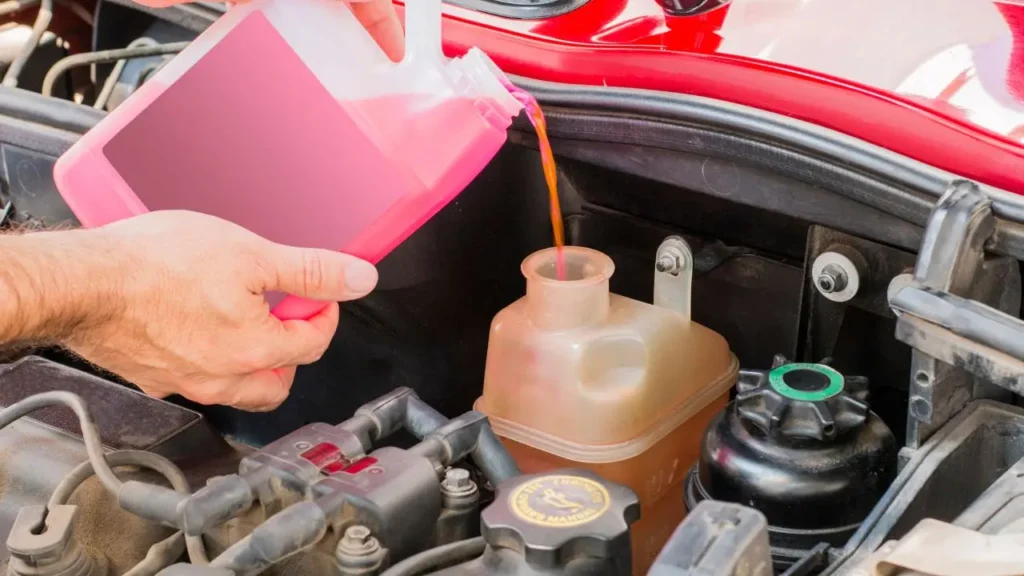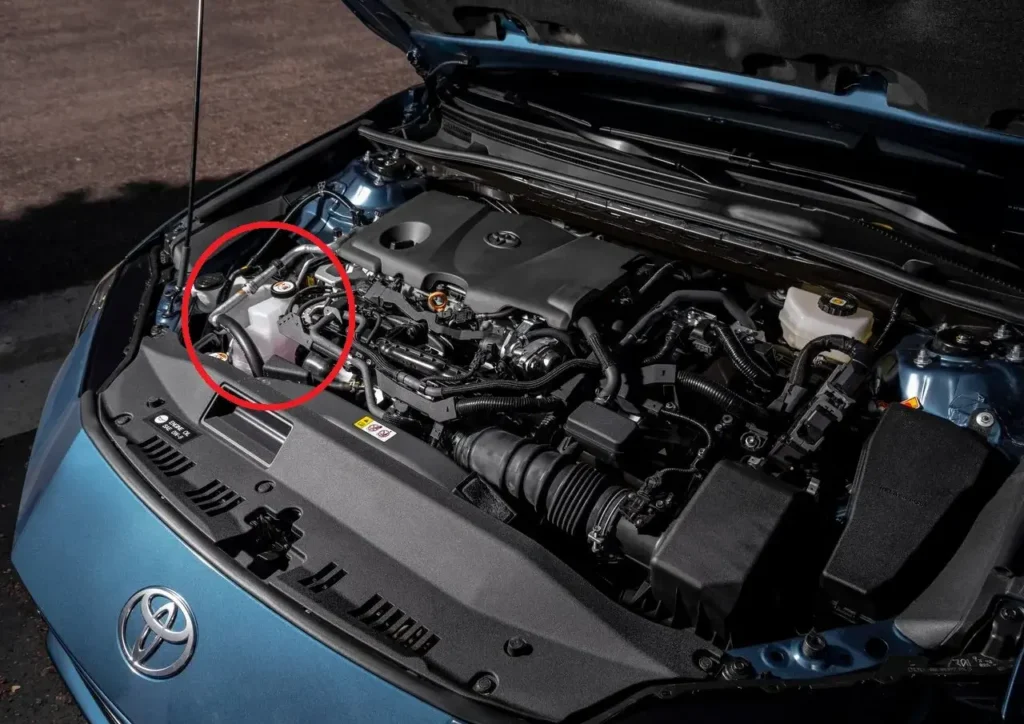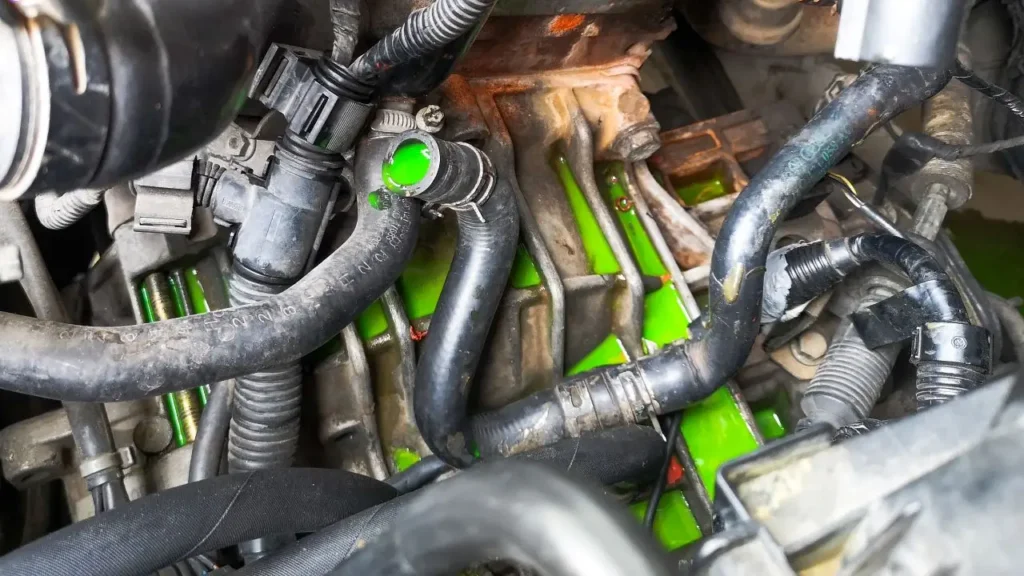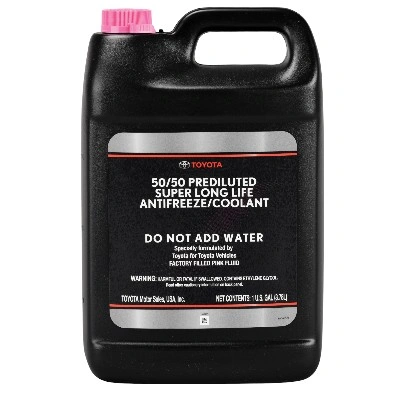Engine coolant is often underestimated and seen as less important than other vehicle fluids. In reality, it’s one of the most critical components in protecting your engine from overheating — a serious issue that can lead to major damage in any type of vehicle.
Because of its vital role, it’s time to start giving your engine coolant the attention it deserves.
In this comprehensive guide, we’ll explain the importance of coolant in your Toyota Camry.
You’ll learn why it matters, how to easily check the coolant level at home, and find specific information on the correct coolant type and capacity for your Camry’s model year.

What is the Coolant?
Engine coolant helps regulate the engine temperature and prevent overheating. It is often called antifreeze, but the two are not the same.
- Antifreeze: Made from ethylene glycol or propylene glycol, it serves as the main ingredient in engine coolant.
- Coolant: A mixture of antifreeze and water, typically in a 50:50 ratio.
Coolant is a mixture of antifreeze and water, usually in a 50:50 ratio. This blend is ideal for engines, as it can cool those operating above 200 degrees Fahrenheit while also preventing freezing in temperatures as low as 30 degrees below zero.
In extremely cold conditions, the ratio may be adjusted to 70 percent antifreeze and 30 percent water for better freeze protection.
Beyond regulating engine temperature, coolant also serves other important functions, including:
- Prevents Corrosion: Protects the radiator, hoses, and metal components from rust and corrosion.
- Lubricates Moving Parts: Helps keep the water pump and other components running smoothly.
- Prevents Damage: Reduces the risk of damage to the water pump, engine block, head gasket, and other parts.
Engine coolant helps regulate temperature by transferring heat away from the engine. It continuously circulates between the engine and radiator through a closed cooling system.
(cars.com)
Checking the Level
You want to make sure there is enough coolant in your Camry to keep it running smoothly. A low coolant level can cause the temperature gauge to rise into the hot zone (H). If this happens for too long, the engine may overheat, leading to serious engine damage.
For this reason, it is important to check your Camry’s coolant level regularly.
Fortunately, checking the engine coolant level is a simple task. All you need to do is look at the coolant reservoir, which is located on the left side of the engine bay (see photo).

Important! Always check the coolant when the engine is completely cold. Never open the reservoir cap or radiator cap while the engine is hot. Hot coolant is under pressure, and opening the cap can cause it to spray, potentially resulting in serious burns.
Tips: In my experience, a simple way to check if the coolant is hot or cold is by touching the radiator cap. If it still feels hot, stop immediately because the coolant is definitely hot. If the radiator cap is cool to the touch, then it is safe to proceed.
Here is a step-by-step guide on how to check the engine coolant level in your Toyota Camry:
- Park you Camry on level ground, engagethe parking brake.
- If your engine still hot, wait until the engine and radiator are completely cool before checking the coolant level.
- Pull the hood release lever inside the car, then unlock and lift the hood and find the coolant reservoir.
- Check the coolant level by looking at the markings on the side of the reservoir to see if the coolant is between the “L” and “F” lines. If the reservoir is dirty, wipe it with a damp cloth for a clearer view.
The coolant level should be between the “L” and “F” lines. If it is within this range, you do not need to take any action, you are good to go.
If the coolant is below the LOW mark, you need to add more fluid. Additionally, it is a good idea to inspect the hose connecting the radiator and reservoir for any signs of leaks or potential damage.
How Often to Change
Although it is rare, there are times when you will need to replace the coolant. This involves draining all the old fluid and refilling it with new coolant.
Toyota generally recommends checking the coolant every 15,000 miles or 18 months, whichever comes first, as part of the Toyota Camry maintenance schedule.
If an inspection reveals signs of contamination, the system will need to be flushed. It is also important to monitor the coolant level and add more fluid if it drops.
However, if you purchased your Camry brand new, there is usually no need to worry. The factory coolant can last up to 120,000 miles without requiring a flush.
After that, it is recommended to change it every 30,000 miles. If you opt for extended drain coolants, the replacement interval can be stretched to 100,000 miles.
Even though your Camry’s coolant can last up to 120,000 miles, it is still important to watch for signs that a flush may be needed.
Signs Your Coolant System Needs a Flush:
- Sweet smell: Overheating ethylene glycol can produce a distinct sweet odor.
- Gurgling noise: This sound often comes from air pockets forming due to low coolant levels.
- Overheating: If the engine coolant temperature gauge enters the red zone, the engine is overheating. Stop the engine immediately and check the fluid level once it has cooled down.
(toyota)
Toyota Camry Coolant Capacity
Like I mentioned earlier, keeping your coolant at the right level is super important. Having too much or too little can lead to some problems you definitely want to avoid.
But before we get into what can happen if the coolant level isn’t right, let me show you a quick table with how much coolant the Toyota Camry takes when it’s time for a coolant change.
| Model Year | Gasoline Engine | Hybrid Engine |
|---|---|---|
| 2025 | – | Engine Coolant: 6.4 qt. (6.1 L) Inverter Coolant: 1.9 qt. (1.8 L) |
| 2024 | 2.5 L Engine: 7.3 qt. (6.9 L) 3.5 L Engine: 9.1 qt. (8.6 L) | Engine Coolant: 6.4 qt. (6.1 L) Inverter Coolant: 1.9 qt. (1.8 L) |
| 2023 | 2.5 L Engine: 7.3 qt. (6.9 L) 3.5 L Engine: 9.1 qt. (8.6 L) | Engine Coolant: 6.4 qt. (6.1 L) Inverter Coolant: 1.9 qt. (1.8 L) |
| 2022 | 2.5 L Engine: 7.3 qt. (6.9 L) 3.5 L Engine: 9.1 qt. (8.6 L) | Engine Coolant: 6.4 qt. (6.1 L) Inverter Coolant: 1.9 qt. (1.8 L) |
| 2021 | 2.5 L Engine: 7.3 qt. (6.9 L) 3.5 L Engine: 9.1 qt. (8.6 L) | Engine Coolant: 6.4 qt. (6.1 L) Inverter Coolant: 1.9 qt. (1.8 L) |
| 2020 | 2.5 L Engine: 7.3 qt. (6.9 L) 3.5 L Engine: 9.1 qt. (8.6 L) | Engine Coolant: 6.4 qt. (6.1 L) Inverter Coolant: 1.9 qt. (1.8 L) |
| 2019 | 2.5 L Engine: 7.3 qt. (6.9 L) 3.5 L Engine: 9.1 qt. (8.6 L) | Engine Coolant: 6.4 qt. (6.1 L) Inverter Coolant: 1.9 qt. (1.8 L) |
| 2018 | 2.5 L Engine: 7.3 qt. (6.9 L) 3.5 L Engine: 9.1 qt. (8.6 L) | Engine Coolant: 6.4 qt. (6.1 L) Inverter Coolant: 1.9 qt. (1.8 L) |
| 2017 | 2.5 L Engine: 7.7 qt. (7.3 L) 3.5 L Engine: 9.6 qt. (9.1 L) | Engine Coolant: 7.6 qt. (7.2 L) Inverter Coolant: 3.4 qt. (3.2 L) |
| 2016 | 2.5 L Engine: 7.7 qt. (7.3 L) 3.5 L Engine: 9.6 qt. (9.1 L) | Engine Coolant: 7.6 qt. (7.2 L) Inverter Coolant: 3.4 qt. (3.2 L) |
| 2015 | 2.5 L Engine: 7.7 qt. (7.3 L) 3.5 L Engine: 9.6 qt. (9.1 L) | Engine Coolant: 7.6 qt. (7.2 L) Inverter Coolant: 3.4 qt. (3.2 L) |
| 2014 | 2.5 L Engine: 7.7 qt. (7.3 L) 3.5 L Engine: 9.6 qt. (9.1 L) | Engine Coolant: 7.6 qt. (7.2 L) Inverter Coolant: 3.4 qt. (3.2 L) |
| 2013 | 2.5 L Engine: 7.7 qt. (7.3 L) 3.5 L Engine: 9.6 qt. (9.1 L) | Engine Coolant: 7.6 qt. (7.2 L) Inverter Coolant: 3.4 qt. (3.2 L) |
| 2012 | 2.5 L Engine: 7.7 qt. (7.3 L) 3.5 L Engine: 9.7 qt. (9.2 L) | Engine Coolant: 7.6 qt. (7.2 L) Inverter Coolant: 3.4 qt. (3.2 L) |
| 2011 | 2.5 L Engine: 7.5 qt. (7.1 L) 3.5 L Engine: 9.5 qt. (9.0 L) | Engine Coolant: 6.6 qt. (6.2 L) Inverter Coolant: 3.1 qt. (2.9 L) |
| 2010 | 2.5 L Engine: 7.5 qt. (7.1 L) 3.5 L Engine: 9.5 qt. (9.0 L) | Engine Coolant: 6.6 qt. (6.2 L) Inverter Coolant: 3.1 qt. (2.9 L) |
| 2009 | 2.5 L Engine: 6.6 qt. (6.2 L) 3.5 L Engine: 9.5 qt. (9.0 L) | Engine Coolant: 6.6 qt. (6.2 L) Inverter Coolant: 3.1 qt. (2.9 L) |
| 2008 | 2.5 L Engine: 6.6 qt. (6.2 L) 3.5 L Engine: 9.5 qt. (9.0 L) | Engine Coolant: 6.6 qt. (6.2 L) Inverter Coolant: 3.1 qt. (2.9 L) |
| 2007 | 2.5 L Engine: 6.6 qt. (6.2 L) 3.5 L Engine: 9.5 qt. (9.0 L) | Engine Coolant: 6.6 qt. (6.2 L) Inverter Coolant: 3.1 qt. (2.9 L) |
| 2006 | 2.5 L Engine: 6.6 qt. (6.2 L) 3.5 L Engine: 9.8 qt. (9.2 L) | – |
| 2005 | 2.5 L Engine: 6.6 qt. (6.2 L) 3.5 L Engine: 9.8 qt. (9.2 L) | – |
| 2004 | 2.5 L Engine: 6.6 qt. (6.2 L) 3.5 L Engine: 9.8 qt. (9.2 L) | – |
| 2003 | 2.5 L Engine: 6.6 qt. (6.2 L) 3.5 L Engine: 9.8 qt. (9.2 L) | – |
| 2002 | 2.5 L Engine: 6.6 qt. (6.2 L) 3.5 L Engine: 9.8 qt. (9.2 L) | – |
| 2001 | 2.5 L Engine: 7.3 qt. (6.9 L) 3.5 L Engine: 9.3 qt. (8.8 L) | – |
| 2000 | 2.5 L Engine: 7.3 qt. (6.9 L) 3.5 L Engine: 9.3 qt. (8.8 L) | – |
| 1999 | 2.5 L Engine: 7.3 qt. (6.9 L) 3.5 L Engine: 9.6 qt. (9.1 L) | – |
| 1998 | 2.5 L Engine: 7.3 qt. (6.9 L) 3.5 L Engine: 9.6 qt. (9.1 L) | – |
| 1997 | 2.5 L Engine: 7.3 qt. (6.9 L) 3.5 L Engine: 9.6 qt. (9.1 L) | – |
| 1996 | 2.5 L Engine: 6.7 qt. (6.3 L) 3.5 L Engine: 9.3 qt. (9.3 L) | – |
Knowing the Toyota Camry coolant capacity from the table above will definitely help when it’s time for a coolant change.
But remember, changing the coolant isn’t something you need to do as often as an oil change. It’s a good habit to check the coolant level regularly, maybe during every oil change or before a long trip.
Just make sure the coolant level stays between the MAX and LOW marks on the reservoir.
If the coolant level is too low, it can cause several problems for your Camry, such as:
- Overheating, which can seriously damage engine components
- Certain engine parts may not get proper cooling, leading to potential damage
- Air can enter the cooling system, reducing its ability to cool the engine effectively

Although coolant is super important for your Camry, adding too much of it isn’t a good idea either. Overfilling the coolant can actually lead to some problems, such as:
- Coolant leaks because of excessive pressure in the system
- Damaged hoses due to the high pressure, and any spilled coolant might even harm electronic components under the hood
Choosing the Correct Coolant Type
It is important to follow the manufacturer’s recommendations for your Toyota Camry, especially when selecting the right coolant. There are various brands and types of coolant designed for different vehicles, so choosing the correct one is essential.
Fortunately, Toyota’s coolant recommendations for the Camry are quite straightforward. Toyota advises using Toyota Super Long Life Coolant or an equivalent for all generations of the Camry, including the Camry Hybrid.

Toyota Super Long Life Coolant comes pre-mixed with 50 percent coolant and 50 percent deionized water. This mixture protects the fluid from freezing down to -35°C.
If you live in an area with extreme cold, you may need a 55 percent coolant and 45 percent water blend, which provides protection down to -44°F (-42°C).
Does Color Matter?
Coolant is available in several different colors.
While the color itself does not affect the chemical performance of the coolant, it serves as an indicator to differentiate between coolant types.
Choosing the correct type of coolant is important, as using the wrong one can negatively affect the cooling system and may lead to long-term damage.
Below are some common coolant colors and their typical applications:
- Green: Commonly used in older vehicles
- Orange: Typically used by manufacturers such as General Motors (GM), Saab, and Volkswagen
- Yellow: Often found in vehicles from Ford, Chrysler, and certain European brands
- Pink or Blue: Commonly used in Asian vehicles such as Toyota, Honda, Nissan, Hyundai, and others
- Purple: Typically used in luxury brands such as Mercedes-Benz, Audi, BMW, and Porsche
For Toyota Camry owners, it is highly recommended to use Toyota Super Long Life Coolant. This ensures optimal compatibility and performance while helping maintain the reliability of the cooling system.
Wrapping-up
So, keeping an eye on your Toyota Camry’s coolant is a straightforward yet crucial part of vehicle maintenance.
By understanding its importance, knowing how to check the level, and using the right type and amount, you can help ensure your Camry runs smoothly for years to come.
So, Do you have any questions about checking or changing your coolant? Feel free to share them in the comments below, or tell us about your own coolant maintenance experiences!